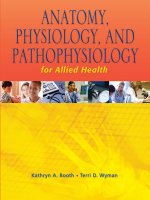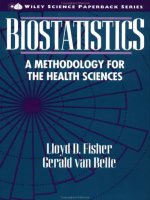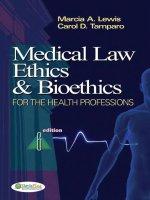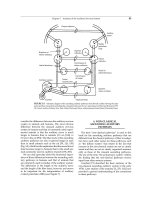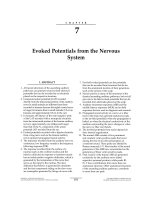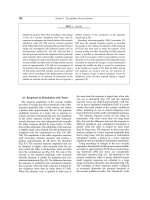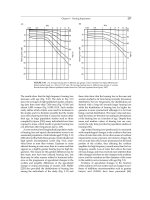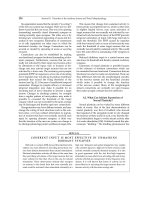Anatomy physiology and disease for the health professions 3rd edition booth test bank
Bạn đang xem bản rút gọn của tài liệu. Xem và tải ngay bản đầy đủ của tài liệu tại đây (83.47 KB, 37 trang )
Chapter 2 Concepts of Chemistry
Multiple Choice Questions
1. The ____ contain the genetic information for the body.
A. carbohydrates
B. lipids
C. nucleic acids
D. proteins
2. Which substances are the structural materials for building solid body parts?
A. Carbohydrates
B. Lipids
C. Nucleic acids
D. Proteins
3. Which of the following is primarily used to make energy?
A. Carbohydrates
B. Lipids
C. Nucleic acids
D. Proteins
4. A(n) ____ is composed of two or more atoms.
A. metabolism
B. molecule
C. ion
D. electrolyte
5. What is the overall chemical functioning of the body?
A. Metabolism
B. Molecule
C. Anabolism
D. Catabolism
2-1
Chapter 2 Concepts of Chemistry
6. Molecules are composed of:
A. at least ten atoms.
B. at least two atoms.
C. two compounds.
D. water and one other atom.
7. An element is any substance that contains one type of:
A. molecule.
B. isotope.
C. atom.
D. proton.
8. The positively charged particles in the nucleus of an atom are:
A. neutrons.
B. electrons.
C. protons.
D. isotopes.
9. Which of the following subatomic particles are found in the nucleus of an atom?
A. Protons and electrons
B. Electrons and neutrons
C. Protons and shells
D. Neutrons and protons
10. The number of protons in an atom is called the:
A. atomic number.
B. atomic weight.
C. mass number.
D. combining weight.
2-2
Chapter 2 Concepts of Chemistry
11. Which subatomic particle determines the chemical activity of an atom?
A. Neutron
B. Proton
C. Electron
D. Prion
12. Different forms of the same element with different numbers of neutrons are called:
A. molecules.
B. compounds.
C. isotopes.
D. lattices.
13. If the atomic number of an element is 9 and the atomic weight is 19, how many neutrons
does the atom have?
A. 10
B. 9
C. 19
D. 28
14. Atoms bonded together to form a chemical unit are called
A. molecules.
B. ions.
C. radioisotopes.
D. buffers.
15. A molecule made of two or more different atoms bonded together is called a(an):
A. ion.
B. isotope.
C. atom.
D. compound.
2-3
Chapter 2 Concepts of Chemistry
16. A bond created from the sharing of electrons between two atoms is a(an) ______ bond.
A. covalent
B. hydrogen
C. ionic
D. metallic
17. The attraction between a slightly positive hydrogen and a slightly negative oxygen of
another molecule describes a(an) ________ bond.
A. hydrogen
B. oxygen
C. nitrogen
D. ionic
18. The most abundant inorganic molecule in living organisms is:
A. water.
B. glucose.
C. oxygen.
D. ammonia.
19. Which of the following is NOT a property of water?
A. Aids in the regulation of body temperature
B. Organic molecule
C. Solvent
D. Inorganic compound
20. Organic compounds always contain ___________ atoms.
A. water
B. carbon
C. nitrogen
D. oxygen
2-4
Chapter 2 Concepts of Chemistry
21. The main function of carbohydrates is to provide:
A. cellular energy.
B. insulation.
C. transport molecules.
D. hereditary information.
22. The most common carbohydrate in the body is:
A. triglyceride.
B. DNA.
C. glucose.
D. protein.
23. Glycogen is:
A. a monosaccharide used for quick energy.
B. a protein found in cell membranes.
C. a form of glucose that is stored in the liver.
D. a fat found in margarine.
24. Which of the following is a carbohydrate?
A. Cholesterol
B. Fat
C. Nucleic acid
D. Starch
25. Which of the following is NOT a function of lipids?
A. Energy storage for cells
B. Formation of antibodies
C. Formation of cell membranes
D. Formation of sex hormones
2-5
Chapter 2 Concepts of Chemistry
26. The lipid molecules that are the main component of cell membranes are:
A. steroids.
B. triglycerides.
C. phospholipids.
D. prostaglandins.
27. Which of the following is NOT a function of proteins?
A. They form structural components of solid body parts.
B. They form many hormones.
C. They form actin and myosin needed for muscular movement.
D. They form important energy molecules.
28. Which of the following is NOT a function of proteins?
A. They form enzymes to speed up reactions.
B. They form the backbone of cell membranes.
C. They form body parts such as muscle.
D. They form antibodies to protect the body from disease.
29. The sum of all the chemical reactions that occur in the body is:
A. emulsification.
B. metabolism.
C. denaturation.
D. synthesis.
30. Which of the following types of reactions involves the production of a larger product by
combining smaller reactants?
A. Degradation
B. Hydrolysis
C. Anabolism
D. Catabolism
2-6
Chapter 2 Concepts of Chemistry
31. Which of the following is a nucleic acid?
A. DNA
B. Steroid
C. Water
D. Glycogen
32. The ___________________ of atoms determine how atoms will react with each other.
A. protons
B. neutrons
C. nuclei
D. electrons
33. If an element has an atomic number of 6 and an atomic weight of 14, how many neutrons
does it have?
A. 6
B. 14
C. 7
D. 8
34. Carbon-12 and carbon-14 are isotopes. They differ in the number of:
A. protons.
B. neutrons.
C. electrons.
D. chemical bonds they can form.
35. An atom with twelve electrons, twelve protons, and fourteen neutrons has an atomic
weight of:
A. fourteen.
B. twenty-four.
C. thirty-eight.
D. twenty-six.
2-7
Chapter 2 Concepts of Chemistry
36. Protons = 7, neutrons = 10, electrons = 7. The atomic weight of this atom is:
A. seven.
B. ten.
C. fourteen.
D. seventeen.
37. A particle in the atom that has neither a negative nor a positive electrical charge is the:
A. electron.
B. element.
C. isotope.
D. neutron.
38. An element is a substance made up entirely of the same type of :
A. atoms.
B. protons.
C. electrons.
D. nucleic acids.
39. An isotope is an atom of an element that varies in mass number due to variation in the
number of:
A. atoms.
B. protons.
C. neutrons.
D. electrons.
40. Which of the following is NOT a lipid?
A. Triglyceride
B. Fat
C. Amino acid
D. Steroid
2-8
Chapter 2 Concepts of Chemistry
41. A subunit of protein is a(n):
A. amino acid.
B. nucleic acid.
C. fatty acid.
D. phospholipid.
42. Which of the following types of molecules contain the most energy per gram?
A. Sugar
B. Carbohydrate
C. Lipid
D. Starch
43. An example of an inorganic molecule is:
A. CaCl2.
B. C2H6.
C. C2H5OH.
D. C3H5(OH)3.
44. The chemistry of living organisms is called _____________.
A. general chemistry
B. organic chemistry
C. inorganic chemistry
D. biochemistry
45. Anabolic steroids used by some athletes are compounds that would be classified as:
A. carbohydrates.
B. nucleic acids.
C. lipids.
D. proteins.
2-9
Chapter 2 Concepts of Chemistry
46. The atomic number of an atom is determined by the number of:
A. protons.
B. neutrons.
C. electrons.
D. protons and neutrons.
47. What is the symbol for sodium?
A. Na
B. S
C. So
D. N
48. On a warm day Tina jumped into the swimming pool and to her surprise the water was
really cold. Which property of water did she discover?
A. Water molecules are cohesive.
B. The temperature of liquid water rises and falls slowly.
C. Water possesses hydrogen bonds.
D. Water is an organic molecule.
49. Which of the following is not one of the four classes of organic molecules found in cells?
A. Vitamins
B. Lipids
C. Proteins
D. Carbohydrates
50. The sex hormones belong to which category of lipids?
A. Steroids
B. Proteins
C. Triglycerides
D. Phospholipids
2-10
Chapter 2 Concepts of Chemistry
51. Which of the following is not a function of proteins?
A. Quick energy
B. Support
C. Transport
D. Enzymes
52. Deoxyribose is a sugar found in ________.
A. glucose
B. enzymes
C. DNA
D. glycogen
53. Which of the following is not an organic molecule?
A. CaCO3
B. C6H12O6
C. C18H34O2
D. CH4
54. What category of biological molecules are steroids included in?
A. Proteins
B. Lipids
C. Carbohydrates
D. Nucleic acids
55. Another name for biochemistry is _____.
A. anatomy
B. physiology
C. physical chemistry
D. biological chemistry
2-11
Chapter 2 Concepts of Chemistry
56. What is the chemical formula for water?
A. CO2
B. CHO
C. H2O
D. C2H2O2
57. A(n) _____ is attraction between two partial electric charges of opposite polarity.
A. atom
B. hydrogen bond
C. covalent bond
D. atomic mass
58. What is the chemical breakdown of complex molecules into simpler molecules with the
release of energy?
A. Catabolism
B. Anabolism
C. Hydrolism
D. Mitosis
59. Which of the following takes up space and has weight?
A. Gravity
B. Matter
C. Light waves
D. Sound waves
60. What is the most abundant element, by percent body weight, in the human body?
A. Calcium
B. Sulfur
C. Oxygen
D. Nitrogen
2-12
Chapter 2 Concepts of Chemistry
61. _____ are gained or lost to make a molecule more stable; they may also be shared, as in
covalent bonds.
A. Atomic neutrons
B. Valence electrons
C. Protons and neutrons
D. Atoms
62. Which of the following is NOT an inorganic molecule?
A. Water
B. Carbon dioxide
C. Oxygen
D. DNA
63. Which type of ion has a positive charge?
A. Electron
B. Neutron
C. Cation
D. Anion
64. Which of the following comments regarding bicarbonate (HCO3-) is NOT correct?
A. This is an inorganic salt.
B. This is a cation.
C. This is an ion.
D. This has a net negative charge.
65. Chromosomes are composed of _____.
A. amino acids
B. glycogen
C. DNA
D. RNA
2-13
Chapter 2 Concepts of Chemistry
66. When _____ reactions in the body result in too much or too little of a substance, it can
adversely affect life.
A. chemical
B. subatomic
C. radioactive
D. biological
67. Lack of water consumption causes _____, which can adversely affect the chemical
reactions in the body.
A. osmosis
B. dehydration
C. loss of sodium ion
D. high blood pressure
68. Because life begins at the _____ level, it is important to know the basic concepts of
chemistry to understand the structures and functions of the human body.
A. systems
B. organ
C. tissue
D. chemical
2-14
Chapter 2 Concepts of Chemistry Key
Multiple Choice Questions
1. (p. 24) The ____ contain the genetic information for the body.
A. carbohydrates
B. lipids
C. nucleic acids
D. proteins
Genetic information is contained in the nucleic acids.
Bloom's: Remembering
Difficulty: Medium
Learning Outcome: 2.3
2. (p. 24) Which substances are the structural materials for building solid body parts?
A. Carbohydrates
B. Lipids
C. Nucleic acids
D. Proteins
Proteins act as structural materials for building solid body parts, such as muscle.
Bloom's: Remembering
Difficulty: Easy
Learning Outcome: 2.3
2-15
Chapter 2 Concepts of Chemistry Key
3. (p. 24) Which of the following is primarily used to make energy?
A. Carbohydrates
B. Lipids
C. Nucleic acids
D. Proteins
Carbohydrates are the body's primary source of energy.
Bloom's: Remembering
Difficulty: Easy
Learning Outcome: 2.3
4. (p. 20) A(n) ____ is composed of two or more atoms.
A. metabolism
B. molecule
C. ion
D. electrolyte
Molecules are made up of at least two atoms.
Bloom's: Remembering
Difficulty: Easy
Learning Outcome: 2.1
5. (p. 20) What is the overall chemical functioning of the body?
A. Metabolism
B. Molecule
C. Anabolism
D. Catabolism
Metabolism is the sum of all the chemical reactions that take place in the body.
Bloom's: Remembering
Difficulty: Easy
Learning Outcome: 2.1
2-16
Chapter 2 Concepts of Chemistry Key
6. (p. 20) Molecules are composed of:
A. at least ten atoms.
B. at least two atoms.
C. two compounds.
D. water and one other atom.
Molecules are composed of at least two atoms.
Bloom's: Remembering
Difficulty: Easy
Learning Outcome: 2.1
7. (p. 20) An element is any substance that contains one type of:
A. molecule.
B. isotope.
C. atom.
D. proton.
An element only contains one type of atom.
Bloom's: Understanding
Difficulty: Medium
Learning Outcome: 2.1
8. (p. 21) The positively charged particles in the nucleus of an atom are:
A. neutrons.
B. electrons.
C. protons.
D. isotopes.
Protons are positively charged and are found in the atomic nucleus.
Bloom's: Remembering
Difficulty: Medium
Learning Outcome: 2.1
2-17
Chapter 2 Concepts of Chemistry Key
9. (p. 21) Which of the following subatomic particles are found in the nucleus of an atom?
A. Protons and electrons
B. Electrons and neutrons
C. Protons and shells
D. Neutrons and protons
Neutrons and protons are located in the atomic nucleus.
Bloom's: Remembering
Difficulty: Medium
Learning Outcome: 2.1
10. (p. 21) The number of protons in an atom is called the:
A. atomic number.
B. atomic weight.
C. mass number.
D. combining weight.
Atomic number is the number of protons in an atom.
Bloom's: Remembering
Difficulty: Medium
Learning Outcome: 2.1
11. (p. 21) Which subatomic particle determines the chemical activity of an atom?
A. Neutron
B. Proton
C. Electron
D. Prion
Electrons determine the chemical activity of an atom.
Bloom's: Remembering
Difficulty: Medium
Learning Outcome: 2.1
2-18
Chapter 2 Concepts of Chemistry Key
12. (p. 21) Different forms of the same element with different numbers of neutrons are called:
A. molecules.
B. compounds.
C. isotopes.
D. lattices.
Isotopes have the same number of protons and different number of neutrons.
Bloom's: Remembering
Difficulty: Medium
Learning Outcome: 2.1
13. (p. 21) If the atomic number of an element is 9 and the atomic weight is 19, how many
neutrons does the atom have?
A. 10
B. 9
C. 19
D. 28
19 - 9 = 10 neutrons
Bloom's: Applying
Difficulty: Medium
Learning Outcome: 2.1
14. (p. 20) Atoms bonded together to form a chemical unit are called
A. molecules.
B. ions.
C. radioisotopes.
D. buffers.
Molecules are atoms bonded together.
Bloom's: Remembering
Difficulty: Easy
Learning Outcome: 2.1
2-19
Chapter 2 Concepts of Chemistry Key
15. (p. 20) A molecule made of two or more different atoms bonded together is called a(an):
A. ion.
B. isotope.
C. atom.
D. compound.
A compound is two or more different types of atoms chemically bonded together.
Bloom's: Remembering
Difficulty: Easy
Learning Outcome: 2.1
16. (p. 20) A bond created from the sharing of electrons between two atoms is a(an) ______
bond.
A. covalent
B. hydrogen
C. ionic
D. metallic
Covalent bonds are formed by the sharing of electrons.
Bloom's: Remembering
Difficulty: Medium
Learning Outcome: 2.1
17. (p. 20) The attraction between a slightly positive hydrogen and a slightly negative oxygen of
another molecule describes a(an) ________ bond.
A. hydrogen
B. oxygen
C. nitrogen
D. ionic
Hydrogen bonds are formed between a hydrogen atom and an electronegative atom, usually in
another molecule.
Bloom's: Understanding
Difficulty: Medium
Learning Outcome: 2.1
2-20
Chapter 2 Concepts of Chemistry Key
18. (p. 22) The most abundant inorganic molecule in living organisms is:
A. water.
B. glucose.
C. oxygen.
D. ammonia.
Water is the most abundant inorganic molecule in living organisms.
Bloom's: Remembering
Difficulty: Easy
Learning Outcome: 2.2
19. (p. 22) Which of the following is NOT a property of water?
A. Aids in the regulation of body temperature
B. Organic molecule
C. Solvent
D. Inorganic compound
Water is inorganic, not organic.
Bloom's: Remembering
Difficulty: Medium
Learning Outcome: 2.2
20. (p. 21) Organic compounds always contain ___________ atoms.
A. water
B. carbon
C. nitrogen
D. oxygen
Organic compounds always contain carbon and hydrogen atoms.
Bloom's: Remembering
Difficulty: Easy
Learning Outcome: 2.2
2-21
Chapter 2 Concepts of Chemistry Key
21. (p. 24) The main function of carbohydrates is to provide:
A. cellular energy.
B. insulation.
C. transport molecules.
D. hereditary information.
Carbohydrates provide energy.
Bloom's: Remembering
Difficulty: Easy
Learning Outcome: 2.3
22. (p. 24) The most common carbohydrate in the body is:
A. triglyceride.
B. DNA.
C. glucose.
D. protein.
Glucose is the most common.
Bloom's: Remembering
Difficulty: Medium
Learning Outcome: 2.3
23. (p. 24) Glycogen is:
A. a monosaccharide used for quick energy.
B. a protein found in cell membranes.
C. a form of glucose that is stored in the liver.
D. a fat found in margarine.
Glucose is stored as glycogen in the liver and skeletal muscles.
Bloom's: Remembering
Difficulty: Medium
Learning Outcome: 2.3
2-22
Chapter 2 Concepts of Chemistry Key
24. (p. 24) Which of the following is a carbohydrate?
A. Cholesterol
B. Fat
C. Nucleic acid
D. Starch
Starch is a carbohydrate .
Bloom's: Remembering
Difficulty: Medium
Learning Outcome: 2.3
25. (p. 24) Which of the following is NOT a function of lipids?
A. Energy storage for cells
B. Formation of antibodies
C. Formation of cell membranes
D. Formation of sex hormones
Antibodies are formed from proteins.
Bloom's: Remembering
Difficulty: Hard
Learning Outcome: 2.3
26. (p. 24) The lipid molecules that are the main component of cell membranes are:
A. steroids.
B. triglycerides.
C. phospholipids.
D. prostaglandins.
A major function of phospholipids is to make cell membranes.
Bloom's: Remembering
Difficulty: Medium
Learning Outcome: 2.3
2-23
Chapter 2 Concepts of Chemistry Key
27. (p. 24) Which of the following is NOT a function of proteins?
A. They form structural components of solid body parts.
B. They form many hormones.
C. They form actin and myosin needed for muscular movement.
D. They form important energy molecules.
Carbohydrates, not proteins, form energy molecules.
Bloom's: Remembering
Difficulty: Medium
Learning Outcome: 2.3
28. (p. 24) Which of the following is NOT a function of proteins?
A. They form enzymes to speed up reactions.
B. They form the backbone of cell membranes.
C. They form body parts such as muscle.
D. They form antibodies to protect the body from disease.
Phospholipids form the backbone of cell membranes.
Bloom's: Remembering
Difficulty: Medium
Learning Outcome: 2.3
29. (p. 20) The sum of all the chemical reactions that occur in the body is:
A. emulsification.
B. metabolism.
C. denaturation.
D. synthesis.
Metabolism is the sum of all the chemical reactions that occur in the body.
Bloom's: Remembering
Difficulty: Easy
Learning Outcome: 2.1
2-24
Chapter 2 Concepts of Chemistry Key
30. (p. 21) Which of the following types of reactions involves the production of a larger product
by combining smaller reactants?
A. Degradation
B. Hydrolysis
C. Anabolism
D. Catabolism
Anabolic reactions use smaller molecules and energy to produce larger molecules.
Bloom's: Remembering
Difficulty: Easy
Learning Outcome: 2.1
31. (p. 24) Which of the following is a nucleic acid?
A. DNA
B. Steroid
C. Water
D. Glycogen
DNA is a nucleic acid.
Bloom's: Remembering
Difficulty: Easy
Learning Outcome: 2.3
32. (p. 21) The ___________________ of atoms determine how atoms will react with each
other.
A. protons
B. neutrons
C. nuclei
D. electrons
Electrons determine how atoms react.
Bloom's: Remembering
Difficulty: Easy
Learning Outcome: 2.1
2-25
